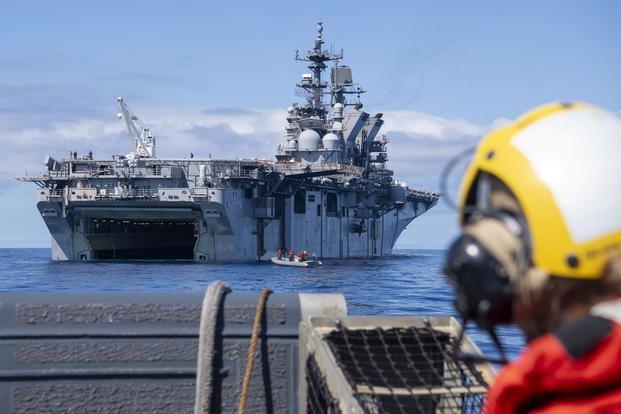The U.S. Navy is moving quickly to bring artificial intelligence and autonomy into the fleet. What was once confined to research projects now shows up in live exercises, Navy contracts, and even high-profile program setbacks. The mix of promise, risk, and accountability is shaping how leaders plan for the fleet of the future.
Hard Lessons at Sea
Autonomy has already proven its value. In 2021, the Navy ran Unmanned Integrated Battle Problem 21, pairing an MQ-9B Sea Guardian drone with the guided-missile cruiser USS Princeton. The drone identified contacts and passed data for strike missions. Rear Adm. James Aiken said the exercise “provides an operations approach to strengthening our manned-unmanned teaming.”
But in August 2025, the risks were on full display. During a test of drone boats off California, one autonomous vessel stalled and was struck by another, which vaulted over its deck before crashing into the water. A separate incident saw a support boat capsize after a towed drone suddenly accelerated. The failures forced the Navy to pause a $20 million contract with L3Harris, a major defense contractor.
Leadership Shake-Up
Program failures have consequences. In May 2025, the Navy relieved Rear Adm. Kevin Smith, who oversaw its unmanned and small combatant programs. Officials cited a “loss of confidence” in his ability to lead, a rare move at that level. The firing sent a clear message: autonomy programs will be judged not just on vision but on execution.
AI in the Deep
While surface drone trials struggle, undersea efforts are moving forward. Washington-based startup Spear AI raised $15 million in July 2025 and secured a Navy contract to use artificial intelligence on submarine passive acoustic data. The software helps sort through vast amounts of noisy underwater sounds to distinguish between whales, weather, or potential threats, a capability long sought by submarine crews.
Allies Push Ahead
The U.S. isn’t alone in this race. In September 2025, Australia announced it will spend A$1.7 billion (about US$1.1 billion) to build a fleet of large autonomous undersea drones called Ghost Shark. The vehicles, developed with U.S. firm Anduril, will carry out intelligence and strike missions and are expected to enter service by early 2026. The investment underscores how quickly allies are scaling their own autonomous fleets.
Another sign of allied momentum came in July 2025, when Australian startup Greenroom Robotics received an AUKUS security exemption to share its navigation software for crewless vessels with U.S. and U.K. partners. The software is already being trialed on patrol boats and research vessels.
What It Means for Sailors
For sailors, these changes are both opportunity and challenge. Training pipelines are shifting toward data and systems expertise. Sailors must learn to supervise AI, operate unmanned vessels, and ensure safe handoffs between human and machine. The Navy still insists humans will remain in control of lethal decisions, but as AI expands, oversight roles will become central.
Balancing Speed with Trust
The strategic context is clear: China and other competitors are investing heavily in autonomy. That creates pressure to move fast. But 2025’s setbacks highlight the danger of fielding systems that aren’t ready. Software bugs, integration failures, and weak oversight risk not only money and equipment but lives and credibility.
The Navy’s challenge is to balance speed with trust. That means demanding higher standards of testing, accountability at senior levels, and realistic doctrine for how much autonomy is acceptable before a human must step in.
Bottom Line
The Navy’s future fleet will be hybrid: crewed warships working alongside unmanned surface and underwater vessels, with AI woven into maintenance, logistics, and targeting. But the lessons of 2025 show that technology alone won’t deliver dominance. Reliability, accountability, and cooperation with allies will be just as decisive as code and steel.
For the sailors who will operate alongside these systems, the message is the same as for admirals in Washington: the AI era is here, but it won’t forgive shortcuts.
Story Continues
Read the full article here

